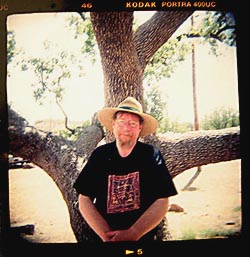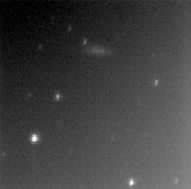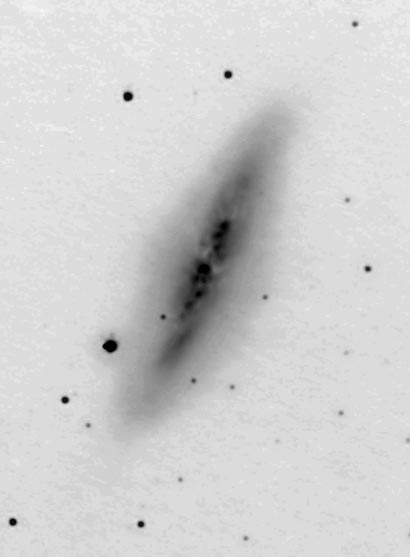Musings on Imaging the Arp Peculiar Galaxies
I started this eight-year adventure with one goal and found a lot of unexpected things. I have learned that most worthwhile things are like this.
In 1995, I started personal research into the Arp Peculiar Galaxies when Dr. Arp was scheduled to speak at the Texas Star Party. At this time, my interest in astronomical observing was flagging. I had finished the Messier list and had half-heartedly started the Astronomical League's Herschel 400. The exotic sounding "Arp Galaxies" pulled me into the literature and the complex universe of galaxy catalogs. Fortunately the internet offered access to information and this modest personal research took on a life of its own.
I found Arp's atlas photographs from his 1966 Atlas to be quite appealing and worthy of extended study. Over the years of study, I learned some things about image planning, processing, and presentation:
Negative presentation has an advantage for showing fainter parts of galaxies. You can stretch a positive image to show these faint parts but it loses some of the natural appearance, particularly with CCD images where you have some signal just above the background noise level (not a problem with Arp's original film images). There is a tremendous amount of stuff going on outside of the normal part of the galaxy we see visually or in normal images. M51 is a good example although my version is not as good as some I have seen. You also get to see why the star chart symbols of galaxies always look a whole lot bigger than what we get to see. Dr. Arp used a printing technique described as "automatic, fluorescent screen dodging" to achieve these dynamic range compressions. I can't visualize how that would work but I am able to approximate it electronically with my images using several techniques:
- Gamma scaling, mostly done using the Image | Adjust | Levels controls in Photoshop. I really like using the sliders so you can rapidly zero in on the most effective scaling.
- A heavy-handed use of transparent Photoshop layers that exaggerates the faintest stuff, derived from a technique used by radio astronomers. With your negative image open in Photoshop, create a duplicate layer. On this top layer, use Image | Adjust | Layers to extremely stretch the image so you are showing only a tiny portion of the histogram saturated, that just above the noise. It makes an awful image but the outline is the outline of the very faintest parts of the galaxy stuff. Then use a Gaussian Blur, adjusting radius so that you have killed the residual noise but not destroyed the shape of the awful image. Then adjust the transparency (20% usually works for me) of this top layer until it becomes a dark haze indicative of the fainter parts of the galaxy. You can then process the bottom layer aggressively (sharpening, stretching) to reveal the structure of the brighter parts. With this technique, I was finally able to show the diamond larger shape of M82.
- Okano's Digital Development Process, available in AIP for Windows and other packages (I have a crude photoshop plugin on one of my pages). This is a digital implementation of a film process that achieves a hyperbolic scaling (I think). I am not very good with this but sometimes it is fabulous.
The framing of multiple galaxy views is an art in itself. Studying Arp's editorial choices, both during planning the images and in cropping my usually larger frames, I came to appreciate his framing both scientifically and aesthetically. Most of his images are cropped from the original plate. I have couple of my images hanging in frames on our walls, owing to the strong composition. I have more to learn in this area.
Pursuing an observing program with a very wide range of field sizes is a challenge. Most of the 338-item catalog has field size smaller than 4 arcminutes, which accounts for depressed interest in this list for CCD imaging. I have had a lot of fun with the smaller fields because most times you can pick out the interesting larger scale features that attracted Dr. Arp. They are obviously undersampled compared to the wonderful mountaintop film images. I am amazed at what you can see and think there may be fun to be had shooting all 338. The smaller number of larger fields have some nice groupings - 51 require an 11 arcminute fields which is great for "half-inch" CCD chips through Schmidt Cass scopes. The largest are the Leo Triplet (68 arcminutes - most of us have to do a mosaic) and a wide field of M101 (34 arcminutes - don't miss the fainter outer stuff). With this range of fields, you need a range of optics, a coincidental convenience due to the evolution of my equipment (see right).
I am not sure what is next for me. I want to reshoot a few now that I have better equipment. Maybe I will try to image the remaining 238, perhaps keeping me busy late into the decade, at the plodding rate of 50 a year. Maybe I should spend a year or two visually observing. I am in the process of acquiring a new camera, a Starlight Xpress MX916 (also from Astromart). More resolution! More sensitivity!
See you in the future,
Dennis

Dennis Webb, the
day of his 100th Arp image,
in the embrace of the bunkhouse tree.
Texas Star Party 2003
Holga photograph by Becky Ramotowski
February 1995 - I start to research the Arp Galaxies, stimulated by Halton Arp's scheduled appearance at the Texas Star Party.
May 1995 - Dr. Arp speaks at the Texas Star Party and I sell pamphlets providing additional details to help amateur astronomers observe his Peculiar Galaxies.
Summer 1995 - I get to study the full size 1966 Atlas of Peculiar Galaxies, courtesy of inter-library loan.
November 1995 - First version of the Arp Webpage online, featuring false color renderings of some Al Kelly CCD images, my first primitive image processing (or torturing).
Summer 1996 - Propose the Arp Observer's Club to the Astronomical League.
February 1997 - Purchase first CCD Camera, a Cookbook 211 through Astromart. Distracts me from use of my recently completed 17.5-inch dob.
March 1, 1997 - Made first Arp image, on my third night of imaging, a poor rendition of M82 with the Cookbook 211 and a 300mm copier lens, piggy backed on my 17.5-inch Dob on homemade equatorial platform:

April 1997 - Purchase first of many used laptops, a Compaq 386. Dragging them around across the state of Texas and out in the night seems to wear them out.
May 1997 - first Texas Star Party where I image. I got one image before it clouded up. A freak wind blew my scope over and soaked my system.
June 1997 - Move the imaging rig to my 10-inch dob on same platform. Learn how to manually guide. Bought a good guiding eyepiece soon thereafter.
September 1998 - Purchase used 200mm Vivitar camera lens for imaging.
December 1998 - Purchase my first really nice mount, a Takahashi EM-1 German equatorial mount via Astromart, curiously from a guy 10 miles from my house. I add appropriate sized Arp views to my observing plans.
1999 - Really productive year of imaging. Over the year I imaged on 40 nights, acquiring 130 images, 24 of these are Arp galaxy views. Imaged 13 Arps at the Texas Star Party in May, my first organized Arp campaign.
January 2000 - upgrade optics to 440mm focal length f/3.6 newtonian, primary mirror and secondary assembly made by Bob Taylor, optical tube by myself. Telescope includes a Saulietis filter wheel for tricolor imaging. Here is M82 with that rig, with a little too much saturation:

August 2000 - Upgrade Cookbook camera from 211 to 245 chip.
May 2001 - TSP, seduced by tricolor imaging, I imaged no new Arps.
October 2001 - Add Low Dark Current modification to the Cookbook 245 camera to try to get fainter stuff.
March 2002 - Purchase Celeston 8 SCT telescope (Astromart again) and adapt to Tak mount. Swear off color for a while. Autoguide with a Quickcam webcam through a 400mm telephoto lens. Here is M82 with this rig:

May 2002 - TSP - imaged 9 Arps, bringing my total to 53. Camera broke on the third night so I borrowed Andy Saulietis' Finger Lakes Instruments IMG-1200. Seems to be a long way to go to get to 100.
March 2003 - Aggressive imaging from home gets the count up to 80 Arps.
May 2003 - TSP, I get the 100th Arp on the last night. Also presented the Texas Star Party "Lone Stargazer" Award for popularizing the Arp list.